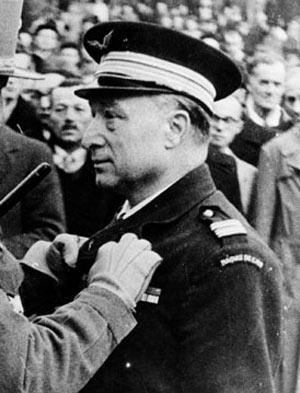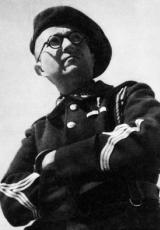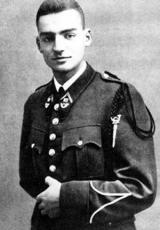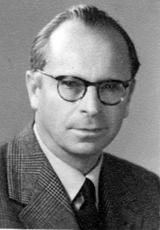Henri Romans Petit

The son of a railway agent, Henri Petit was born on 13 February 1897 at Firminy, in the Loire department.
He studied at the lycée in Saint Etienne and, in 1915, signed up for the duration of the war in the 13th Light Cavalry Battalion. He was promoted to the rank of Corporal and then Sergeant, and received an Order of the Army citation and the Légion d'Honneur. Admitted to Saint-Cyr military school in 1918 as part of the reserves, he graduated an aspirant. Transferred to Aviation, he joined the B.R.127 squadron, assigned to daytime bombing. He was named Second Lieutenant before being discharged.
He went back to school in Lyon, earning a “licence” degree in law and then worked in public relations and advertising for publishing houses. In 1928, he founded the Stefa advertising agency in Saint Etienne.
As a reserve aviation captain, he was called up in August of 1939 and commanded the air bases at Cannes and Nice. He did not accept the armistice of June 1940 and tried in vain to join General Charles de Gaulle in London. In 1942, Henri Romans-Petit arrived in the Ain department, where he immediately contacted the Resistance. After a few months, in December 1942, he began to organise accommodations for people who refused the Compulsory Work Service (STO).
In June 1943, near Mongriffon, he set up a staff school to train Maquisards, whose numbers in the region were on the rise.
In July 1943, the camps, which did not contain more than 60 men for safety and mobility reasons, were fully structured. At the same time, there were more and more contacts between the Ain Maquis and the Armée Secrète (AS – Secret Army).
In September, under the direction of Romans-Petit, the Maquisards achieved two major feats: they took an “Intendance des Chantiers de Jeunesse” depot in Artemare and the “Intendance de l'Armée” in Bourg-en-Bresse.
In October 1943, Romans-Petit became a military leader in charge of the Armée Secrète (AS – Secret Army) for the Ain department.
On 11 November 1943, he organise the famous parade by part of his troops (250 men) in Oyonnax.
In front of a surprised, and then delighted, crowd, he laid a wreath in the shape of the Cross of Lorraine at the war memorial before leaving town in good order. The Oyonnax parade, filmed by Henri Jaboulay’s son, was widely reported in the underground press and on London radio, and had a major impact on the French population and on the Allies, for whom the armed French resistance was no longer just an abstract idea. At the end of the year, as the number of paramilitary fighters in the Ain department (AS and Maquis) reached 2,000 men, he took control of the underground forces and the AS of the Haute-Savoie department, replacing Commander Vallette d'Osia; he applied the same principles as in the Ain: staff training school, short actions with rapid retreat. He worked in liaison with London through the “Musc” mission, comprising Jean Rosenthal (Cantinier), in charge of Maquis inspections, and Richard Heslop (Xavier) of the British SOE.
To meet the needs of weapons parachute drops, he chose the Plateau des Glières near Annecy where, in January 1944, all the Maquisards in the department came together.
He returned to the Ain after turning command of Les Glières over to “Tom” Morel.
When 5,000 Germans, backed up by aviation, massively attacked the Maquis camps of the Ain, massacring the Maquisards, Romans-Petit immediately went to the site on skis, looking for survivors and slipping past the Germans. He then reorganised the Maquis and met the head of the forces in the Haut-Jura department.
On 6 April 1944, several thousands Wehrmacht soldiers came together in the Ambérieu region and launched an attacked the next day. Colonel Romans-Petit then decided to disperse the Maquis; they nonetheless organised nighttime sabotage operations. The Germans took revenge on the villages of Oyonnax and Saint-Claude, amongst others. On 6 June 1944, informed of the Normandy landing, the Maquisards destroyed the depot in Ambérieu, a major centre of the railway network for the southeast. Fifty-two locomotives and ten machines tools were put out of service.
That same month, Henri Romans-Petit was named a Compagnon de la Libération by decree signed by General de Gaulle.
On 11 July 1944, the Germans attempted a major counter-offensive with some 27,000 men. The 5,000 Maquisards under Colonel Romans-Petit were able to resist despite the violent fighting. In September, the Ain department was liberated.
After the war, Henri Romans-Petit went back to his job in advertising. He was also a corporate officer, notably in electronics. Honorary President of the Veterans of the Ain and Haute-Savoie Maquis and President of the National Association of Air Resistance Fighters (Association nationale des Résistants de l'Air), he was also a member of the LICRA executive committee.
He was the author of several books on the war, notably “Les Obstinés” and, in 1974, “Les Maquis de l'Ain”.
Henri Romans-Petit died on 1 November 1980 in Ceignes, in the Ain department. His funeral ceremony was held at the Val d'Enfer memorial in Cerdon (Ain).
He was buried in the cemetery of Oyonnax.
- Grand Officer of the Légion d'Honneur
- Compagnon de la Libération - decree of 16 June 1944
- Croix de Guerre 14/18
- Croix de Guerre 39/45
- Médaille de la Résistance
- Officer of the Legion of Merit (USA)
- Distinguished Service Order (GB)
- Officer of the Order of Leopold (Belgium)
- Croix de Guerre (Belgium)
- Grand Officer of the Nicham Iftikhar
- Commander of the Order of Merit (Congo)
- Officer of the Order of Merit (Cameroon)
Henri Romans-Petit is the author of:
-
Les Obstinés, Editions Janicot, Lille 1945
-
L'Appel de l'aventure, Editions Dorian, Saint-Etienne 1947
-
Les Maquis de l'Ain, Hachette, Paris 1974




